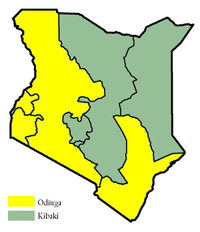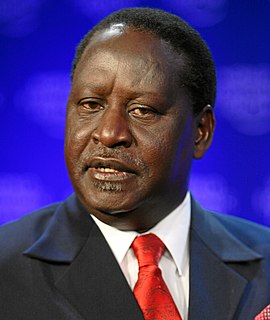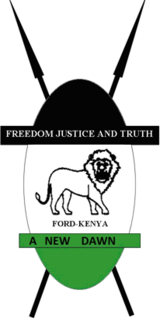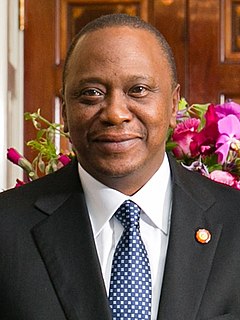| ||||||||||||||||
| ||||||||||||||||
 Presidential election results map. Green denotes provinces won by Kibaki, and Yellow denotes those won by Odinga. | ||||||||||||||||
| ||||||||||||||||
 |
|---|
| This article is part of a series on the politics and government of Kenya |
|
| Foreign relations |
Economic schemes |
General elections were held in Kenya on 27 December 2007, [1] electing the President, National Assembly and local councils.

Kenya, officially the Republic of Kenya, is a country in Africa with 47 semiautonomous counties governed by elected governors. At 580,367 square kilometres (224,081 sq mi), Kenya is the world's 48th largest country by total area. With a population of more than 52.2 million people, Kenya is the 27th most populous country. Kenya's capital and largest city is Nairobi while its oldest city and first capital is the coastal city of Mombasa. Kisumu City is the third largest city and a critical inland port at Lake Victoria. Other important urban centres include Nakuru and Eldoret.

The President of the Republic of Kenya is the head of state and head of government of Kenya. The president leads the executive branch of the Government of Kenya and is the commander-in-chief of the Kenya Defence Forces. The official residence of the president is at State House, Nairobi. The wife of the President is referred to as the First Lady of Kenya.

The National Assembly is the lower house of the Parliament of Kenya. Prior to the 11th Parliament in 1966 when the Parliament moved to become bicameral, it served as a unicameral house.
Contents
- Background
- Presidential candidates
- National Assembly
- Campaign
- President
- National Assembly 2
- Opinion polls
- Results
- President 2
- National Assembly 3
- Aftermath
- See also
- References
The presidential elections were a two-horse race between incumbent Mwai Kibaki, running on a Party of National Unity (PNU) ticket and Raila Odinga, leader of the Orange Democratic Movement (ODM). They were strongly marked by tribal hostility, with Kibaki a member of the traditionally dominant Kikuyu ethnic group, gaining much support amongst the Kikuyu and neighbouring groups in central Kenya, including the Embu and Meru. Odinga, as a member of the Luo ethnic group, succeeded in creating a wider base by building a coalition with regional leaders from the Luhya in Western Kenya, Kalenjin from the Rift Valley and Muslim leaders from the Coast Province. Kibaki was declared the winner with 46% of the vote, and was sworn in at State House on 30 December. However, opposition leader Raila Odinga also claimed victory, [2] [3] and civil unrest broke out resulting in the deaths of several hundred people and the displacement of up to 600,000. This was ended by the National Accord and Reconciliation Act, which led to Odinga being appointed as Prime Minister.

Mwai Kibaki, C.G.H. is a Kenyan politician who was the third President of Kenya, serving from December 2002 until April 2013.

Party of National Unity (PNU) was founded as a political coalition of parties in Kenya. On 16 September 2007, Kenyan President Mwai Kibaki announced the party formation and said that he would run as its presidential candidate in the December 2007 Kenyan elections. It has since become a political party in its own right following conditions set by the Political Parties Act, passed in Kenya in 2008.

Raila Amolo Odinga is a Kenyan politician who served as Prime Minister of Kenya from 2008 to 2013, and has served as Leader of the Opposition since 2013. He was Member of Parliament (MP) for Langata from 1992 to 2013. He served in the Cabinet of Kenya as Minister of Energy from 2001 to 2002, and as Minister of Roads, Public Works and Housing from 2003 to 2005. Odinga was appointed High Representative for Infrastructure Development at the African Union Commission in 2018.
In the National Assembly elections, the ODM won 99 of the 208 seats, with the PNU finishing second with 43 seats. The Kenya African National Union, which had ruled the country from independence until 2002 was reduced to being the fourth-largest party with only 15 seats. Only 71 of the 190 sitting MPs were re-elected, twenty ministers lost their seats and a record 15 female MPs were elected. [4]

The Kenya African National Union (KANU) is a Kenyan political party that ruled for nearly 40 years after Kenya's independence from British colonial rule in 1963 until its electoral loss in 2002. It was known as Kenya African Union (KAU) from 1944 to 1952.KAU was banned by the colonial government from 1952 to 1960.It was re-established by James Gichuru in 1960 and renamed to KANU on 14 May 1960 after a merger with Tom Mboya's Kenya Independence Movement.
There is agreement in the international community that the presidential elections were at least partially manipulated. [5] In July 2008, an exit poll commissioned by the US was released, revealing that Odinga was predicted to have won the presidency by a comfortable margin of 6%, 46% to 40%, well outside the exit poll's 1.3% margin of error. [6]












